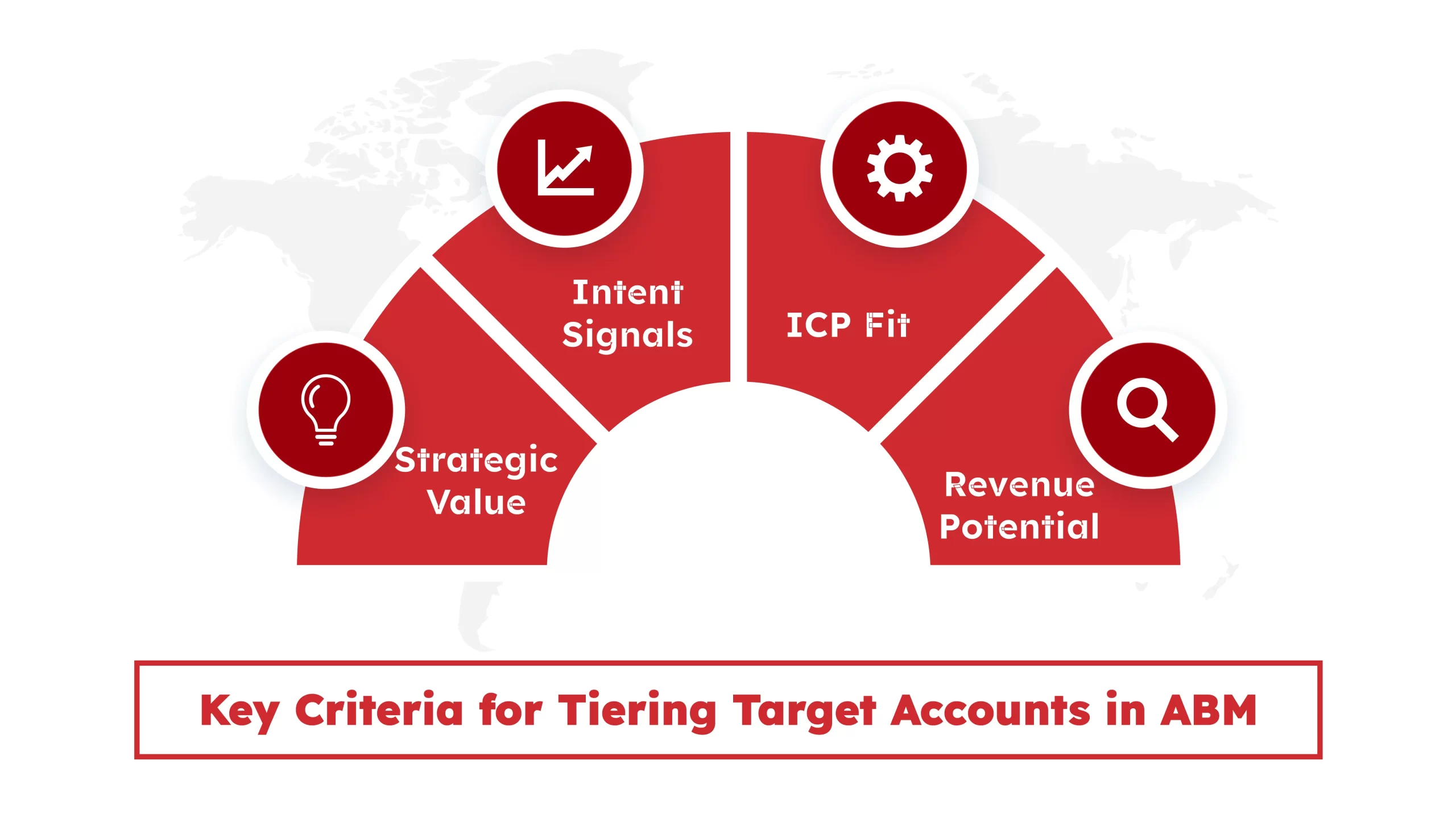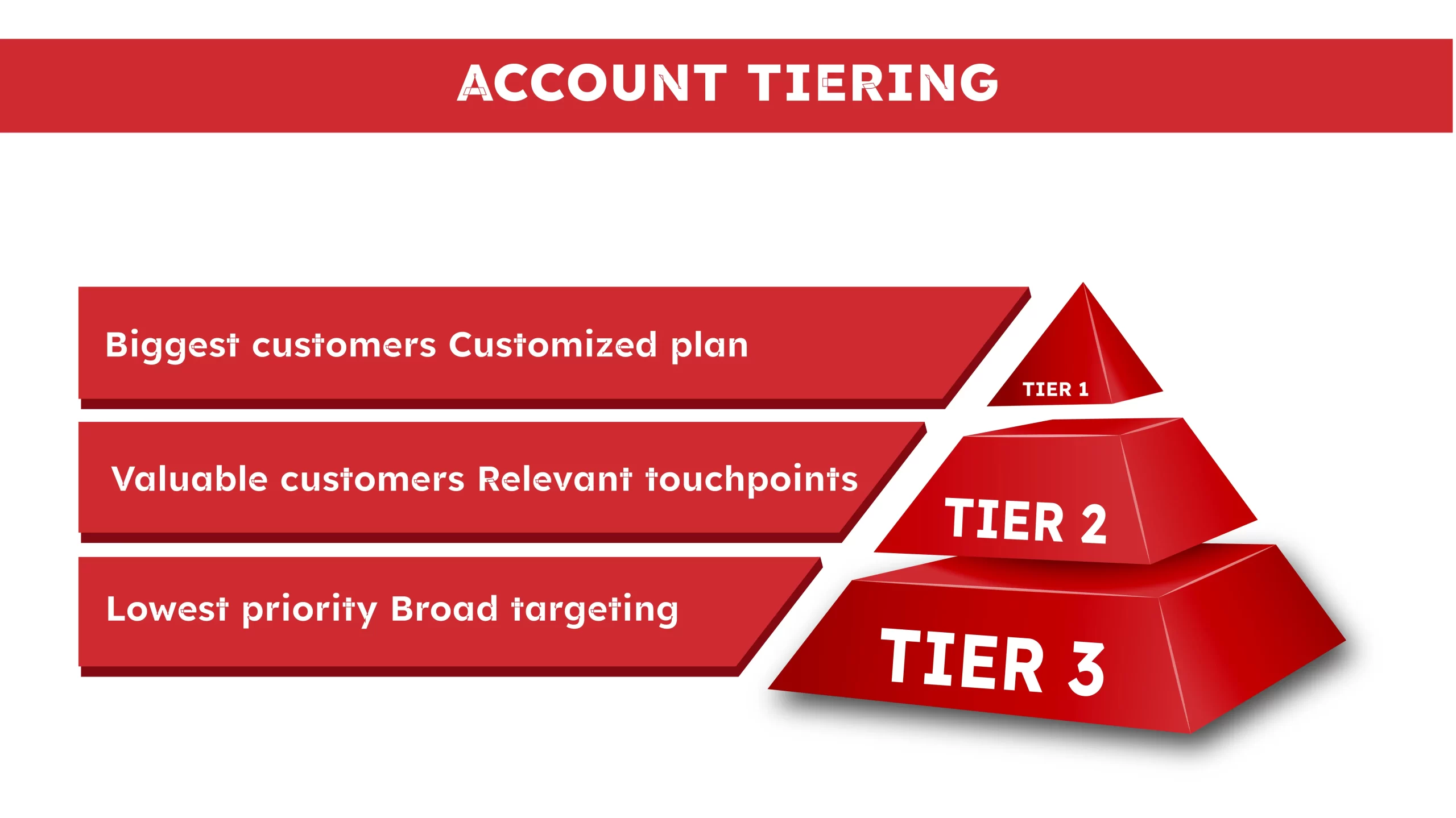You’ve built a product that solves a real problem for your target market. But are your sales and marketing teams targeting the right accounts to sell it?
Today, many B2B teams use account-based marketing (ABM) to create personalized campaigns that are hyper-focused on high-value prospects with great revenue potential. And 93% of marketers have seen very successful results like higher deal sizes, better win rates, and shorter sales cycles.
But here’s something most ABM teams struggle with: Pivoting their ABM strategy when they have time, budget, or resource constraints. They wonder if they can still scale their ABM efforts without watering them down.
That’s where account tiering can help create a more focused resource allocation plan by developing customized strategies for different prospect segments.
In this article, we’ll provide a breakdown of how account tiering in ABM helps you do more with less and improve your ROI. We’ll also discuss the strategies to identify and tier your ABM accounts for streamlining your sales cycle.
What Is Account Tiering in ABM?
ABM account tiering involves categorizing your ABM accounts into different buckets, so you can focus your marketing and sales efforts where they’ll drive the greatest impact. That’s because even with a solid ABM strategy that focuses on accounts with great potential, not all accounts can have the same priority.
For example, a lead that showed recent interest in a personalized product demo, had three of their decision-makers attend your last webinar, and just secured a series B funding? Definitely a high-priority account.
On the other hand, a lead that downloaded your gated whitepaper three months back but hasn’t opened any of your marketing emails since then would count as a low-priority lead.

When you create a tiered target account list in ABM, you categorize accounts based on their:
- Strategic value: Understanding whether a logo would help boost your credibility and increase your chances of unlocking more opportunities.
- Intent signals: Knowing if they’re actively searching for solutions, you offer
- ICP fit: Comparing the account with your ideal customer profile (firmographics, technographics, industry, and use case).
- Revenue potential: Targeting accounts with high current value and strong long-term upside and not just deal sizes, but also cross-sell, upsell, and expansion opportunities.
Why Do You Need Account Tiering in ABM?
In an episode of The Revenue Growth Architects podcast, the speakers discussed different scenarios when ABM tiering can be an effective strategy for your business. You can go for the ABM account tiering approach when:
- You have more good-fit accounts than the capacity to act
- Your marketing and sales teams need a strategic alignment
- Your ICP isn’t clearly defined, and as a result, it’s not delivering
- You’re trying to scale your ABM beyond just top-tier logos
- Your product is costly, and you want to match with accounts that justify the high-acquisition cost
- You want to increase your sales velocity
How To Tier Target Accounts in Your ABM Strategy
Here are some of the best practices for ABM account segmentation and tiering:
1. Define Clear Goals
Understand what business goals you’re trying to achieve with your target accounts. These goals could be:
- Re-engaging with previously lost high-value prospects
- Accelerating active deals and pushing them down the funnel
- Upselling or cross-selling existing customers
- Retaining valuable customers who are nearing their contract expiration
- Breaking into new markets or attracting new accounts
Once your goals are defined, you can set KPIs for different tiers to measure campaign performance. For example:
- The tier 1 accounts could use Conversion Rates as the KPI, since these campaigns are highly personalized and typically focus on moving the account through the funnel.
- The tier 3 accounts could be tracked using Website Traffic, as the goal is broader awareness at scale.
2. Refine Your ICP Blueprint
Your ideal client profile (ICP) is the core component of your ABM strategy as it helps you identify the accounts worth targeting as part of your campaign. Without it, you’d be running your campaigns without a clear idea about what your customers actually expect and how your product can fulfill it.
To help you refine your ICP and identify accounts that are most likely to do business with you, we’ve linked a resourceful ICP template below, thoughtfully created by Growth Business Templates:
As you can see, it maps out every single detail from demographics and firmographics to buying behavior and helps you pinpoint the common problems of your target market better.
3. Find the Right Accounts with Big Potential
Once you have a well-defined ICP, the next step is to start building the target account list with profiles that match it. You can pick these accounts from sources like:
- Your inbound marketing funnel
- CRM or sales pipeline data
- Third-party data providers
Next, prioritize accounts based on fit and potential value using account scoring.
Account scoring in ABM is used to rank leads based on how much they match your ICP and their engagement and conversion potential. When it comes to account tiering, it helps you determine which accounts you should focus on more and which accounts could use a less personalized approach.
4. Map Accounts into ABM Tiers
The final step involves mapping the sorted list of ABM accounts into different tiers and aligning your marketing and sales efforts around that. And once you have your tiered account list, you might be dealing with hundreds of accounts (sometimes more).
A tier-based ABM strategy typically assigns accounts into three tiers:
- Tier 1 (Strategic ABM): Your most important accounts go into this tier. Each account gets a 1:1 treatment with highly personalized campaigns, targeted messaging, custom content, and close collaboration with your sales and marketing teams.
- Tier 2 (Scale ABM): Accounts in this tier have good potential to be your ICP. You follow a one-to-few approach here with a semi-personalized outreach and targeted nurture programs designed to warm them into Tier 1 over time.
- Tier 3 (Programmatic ABM): These accounts are your broader ICP, but at lower value or earlier-stage intent. It mainly follows a one-to-many approach, engaging with multiple accounts with automated emails, digital ads, and limited SDR outreach.
Below is a visual representation of how account-based tiers are formed in a B2B setting:

After categorizing each ABM account into its dedicated tiers, you can start allocating budget based on the priority of each tier. Additionally, create an outreach and engagement plan per tier, focusing on your:
- Messaging strategy
- Outreach channels
- Measurement and tracking approach
Examples of Brands Acing ABM Account Tiering
An ABM account tiering strategy can differ from brand to brand. While most teams segment accounts based on lead quality, intent signals, and revenue potential, how they plan messaging and execute engagement may vary.
Below are two examples of brands implementing ABM tiering at different stages of their businesses:
Snowflake’s Early-Stage Winning ABM Strategy
Snowflake, an AI-powered analytics platform, launched its ABM program when it had fewer target accounts. Here’s how they segregated their accounts into different tiers:
| Category | Tier 1 | Tier 2 | Tier 3 |
|---|---|---|---|
| Number of accounts | Targeted 3–4 top accounts nominated by regional sales VPs. | Targeted 5–7 key accounts nominated by account executives | Targeted 3–4 active accounts, based on regional themes and intent signals |
| Goal | Building influence in the customer buying center, generating deep awareness, and tailoring messaging by role | To support current/future pipeline growth with personalized targeting | Drive first engagement and meetings through intent-based targeting at scale |
| Programs | • 1:1 events • Custom direct mail • 1:1 advertising • Microsites for each account • Custom content based on the account’s pain points or topics of interest |
• Custom ads • A microsite featuring hand-curated content and events • A personal note from the rep • Tailored SDR outreach |
They leveraged the intent data to understand topics that are most relevant to these accounts and decided to follow up with these cross-functional marketing efforts:
• Personalized microsite to get visitor insights |
Here’s how they craft their SDR touchpoint when doing 1:1 outreach:

Additionally, their 1:1 SDR outreach sequence consisted of the following multiple touchpoints spanning over 24 days to engage a high-value account.

Today, Snowflake has 5000+ customers in North America alone, and they now majorly focus on alignment at scale. Also, post this campaign, their meeting rate increased by up to 4x, and deal velocity became 2x faster.
Thomson Reuters’ 95% Win Rate Approach
Thomson Reuters launched its ABM program targeting 500 strategic accounts. They tiered them into three categories based on fit, renewal timing, and sales cycle complexity.
| Category | Tier 1 (100 accounts) | Tier 2 (200 accounts) | Tier 3 (200 accounts) |
|---|---|---|---|
| Type | High-risk renewal accounts with active sales cycles that are 18 months from closing. | High-fit accounts that are in active renewal discussions but not engaging with sales. | High-fit accounts that are new and will likely have a longer sales cycle. |
| Tactics | • Each account had a 1:1 marketing owner managing a custom campaign. • They hosted and catered demos inside clients’ offices. • They positioned client executives as speakers at high-profile industry events |
• They sent dimensional mailers or branded gifts to break into key conversations. • They offered free or discounted product trials to entice new stakeholders. • They hosted executive-level events to engage decision-makers (C-suite, VPs) |
• They launched personalized account-based ads to stay top-of-mind. • They sent event invites and localized marketing for in-market engagement. |
Ready To Elevate Your ABM Efforts?
Tiering ABM accounts takes initial effort and requires you to spend enough time understanding your target audience and their core problems. But the payoff of such targeted outreach and engagement can be significant.
You could be driving higher conversions, stronger pipeline velocity, and better ROI from your top accounts without wasting any budget on low-intent leads.
Make Marketboats your ally in your ABM efforts and activate targeted campaigns that convert.
